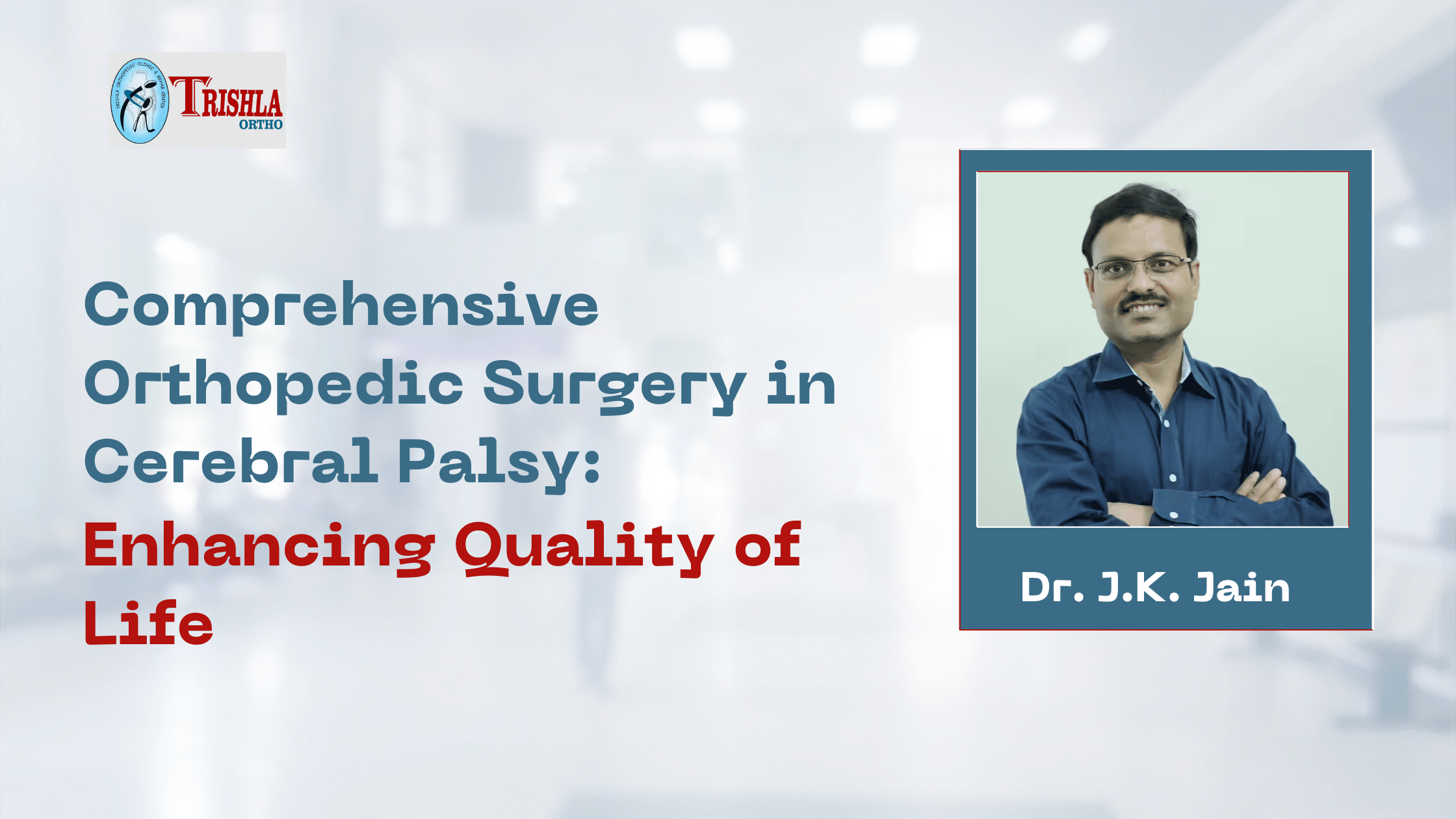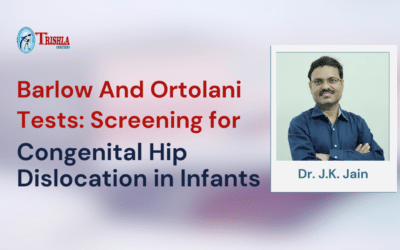Cerebral palsy is a neurological condition that affects muscle control and movement, resulting in various challenges for individuals living with the condition. Orthopaedic surgery plays a crucial role in managing the orthopaedic complications associated with cerebral palsy, aiming to improve mobility, correct deformities, and enhance the overall quality of life. From tendon lengthening and muscle release to joint stabilization and osteotomy, various surgical procedures are employed to address the specific needs of each individual with cerebral palsy.
In this comprehensive blog, we will explore the world of orthopedic surgery in cerebral palsy, delving into common surgical procedures and their goals. We will discuss how orthopedic surgery can alleviate pain, correct deformities, and improve functional abilities for individuals with cerebral palsy. Additionally, we will highlight the role of the renowned orthopaedic centre Trishla Ortho in providing specialized and comprehensive care for individuals with cerebral palsy, emphasizing their expertise, individualized treatment plans, and advanced surgical techniques.
Join us as we delve into orthopaedic surgery in cerebral palsy, uncovering the transformative impact it can have on individuals living with this condition.
Understanding Orthopedic Surgery in Cerebral Palsy
Orthopaedic surgery plays a vital role in addressing the musculoskeletal challenges individuals with cerebral palsy face. Cerebral palsy affects muscle control and movement due to damage to the brain, leading to abnormalities in muscle tone and coordination. These abnormalities can result in contractures, deformities, joint instability, and other orthopaedic issues.
Orthopaedic surgery in cerebral palsy aims to improve mobility, correct deformities, relieve pain, and enhance overall function. It involves a range of surgical procedures tailored to the specific needs of each individual. Tendon lengthening, muscle release, joint stabilization, and osteotomy are common surgical techniques for managing cerebral palsy.
Tendon lengthening involves the surgical lengthening of tight or contracted tendons to improve the range of motion and reduce muscle spasticity. Muscle release surgery focuses on releasing or lengthening overly tight or spastic muscles, improving balance, posture, and function. Joint stabilization procedures address joint instability and prevent dislocations, often through ligament reconstruction or bone realignment. Osteotomy involves cutting and reshaping bones to correct deformities and improve alignment, promoting proper weight-bearing and enhancing mobility.
Orthopaedic surgery in cerebral palsy requires a multidisciplinary approach involving collaboration between orthopaedic surgeons, rehabilitation specialists, and other healthcare professionals. This comprehensive care ensures that the surgical interventions are part of a broader treatment plan that includes rehabilitation therapies, assistive devices, and ongoing support.
Common Orthopedic Surgical Procedures in Cerebral Palsy
Orthopedic surgical procedures in cerebral palsy are tailored to address individuals’ specific musculoskeletal challenges. These procedures aim to correct deformities, alleviate pain, improve mobility, and enhance overall function. Here are some common orthopaedic surgical procedures performed in cerebral palsy:
Tendon Lengthening
This procedure involves surgically lengthening tight or contracted tendons. By releasing the tension in the affected muscles, tendon lengthening helps improve the range of motion, reduce muscle spasticity, and enhance functional abilities.
Muscle Release
Muscle release surgery targets overly tight or spastic muscles. By releasing or lengthening these muscles, balance, posture, and overall function can be improved. This procedure allows for better alignment and coordination of movements.
Joint Stabilization
Joint stabilization procedures address joint instability and prevent dislocations. Surgeons may reconstruct ligaments, realign bones, or utilize external fixation devices to stabilize and optimize joint function. Joint stabilization surgeries improve stability, reduce pain, and enhance mobility.
Osteotomy
Osteotomy involves the cutting and reshaping of bones to correct deformities and improve alignment. This procedure is particularly helpful in cases where there are significant bone abnormalities. Osteotomy can help restore proper weight-bearing, improve joint mechanics, and enhance overall mobility.
Each surgical procedure is tailored to the individual needs and specific orthopaedic challenges of the person with cerebral palsy. The choice of procedure depends on factors such as the severity of deformities, age, functional goals, and overall health. By addressing the musculoskeletal issues through these surgical interventions, orthopaedic surgeons play a crucial role in improving individuals’ quality of life and functional independence with cerebral palsy.
The Role of Trishla Ortho in Orthopedic Surgery for Cerebral Palsy
Trishla Ortho, a renowned orthopaedic centre, specializes in providing comprehensive care for individuals with cerebral palsy. Their multidisciplinary approach combines the expertise of orthopaedic surgeons, rehabilitation specialists, and assistive technology professionals to deliver holistic and personalized treatment.
- Expert Surgeons: Trishla Ortho is home to highly skilled and experienced orthopedic surgeons who manage cerebral palsy. Their expertise and proficiency ensure the highest level of surgical care and outcomes.
- Individualized Treatment Plans: Trishla Ortho understands that each person with cerebral palsy has unique needs. Their team of specialists creates customized treatment plans to address each individual’s unique orthopaedic challenges. These plans are tailored to maximize functional abilities and enhance overall quality of life.
- Advanced Surgical Techniques: Trishla Ortho incorporates the latest advancements in orthopaedic surgery, utilizing minimally invasive techniques whenever possible. These techniques promote faster recovery, minimize scarring, and reduce post-operative pain.
- Rehabilitation and Assistive Technology: Trishla Ortho recognizes that orthopaedic surgery is only one aspect of comprehensive care. They provide comprehensive rehabilitation programs, including physiotherapy and occupational therapy, to optimize surgical outcomes. Additionally, they offer assistive devices and adaptive technology to support individuals in achieving their highest level of independence.
Final Takeaway,
Orthopaedic surgery plays a significant role in managing the musculoskeletal challenges individuals with cerebral palsy face. Through tendon lengthening, muscle release, joint stabilization, and osteotomy, orthopaedic surgery aims to improve mobility, correct deformities, and enhance overall function. Trishla Ortho, with its team of expert surgeons, personalized treatment plans, advanced surgical techniques, and comprehensive rehabilitation services, is at the forefront of providing comprehensive orthopaedic care for individuals with cerebral palsy. Their commitment to improving the lives of individuals with cerebral palsy through orthopaedic surgery makes them a valuable resource for those seeking specialized care and support.
Reference link –
https://www.ncbi.nlm.nih.gov/pmc/articles/PMC5439309/
https://www.wjgnet.com/2218-5836/full/v11/i4/222.htm
https://jamanetwork.com/journals/jama/article-abstract/319640











